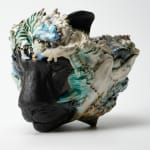Oishi Sayaka 大石早矢香 Japanese, b. 1980
ANIMA bowl (Lion) ANIMA 盌, 2024
Stoneware
H6 1/4 × W7 7/8 × D5 1/2 in.
H16 × W20 × D14cm
H16 × W20 × D14cm
With signed wood box
Further images
-
(View a larger image of thumbnail 1
)

-
(View a larger image of thumbnail 2
)

-
(View a larger image of thumbnail 3
)

-
(View a larger image of thumbnail 4
)

-
(View a larger image of thumbnail 5
)

-
(View a larger image of thumbnail 6
)

-
(View a larger image of thumbnail 7
)

-
(View a larger image of thumbnail 8
)

-
(View a larger image of thumbnail 9
)

-
(View a larger image of thumbnail 10
)

-
(View a larger image of thumbnail 11
)

-
(View a larger image of thumbnail 12
)

-
(View a larger image of thumbnail 13
)

-
(View a larger image of thumbnail 14
)

-
(View a larger image of thumbnail 15
)

-
(View a larger image of thumbnail 16
)

-
(View a larger image of thumbnail 17
)

-
(View a larger image of thumbnail 18
)

-
(View a larger image of thumbnail 19
)

-
(View a larger image of thumbnail 20
)

Oishi Sayaka was born in Kyoto, Japan, in 1980. She pursued her education in ceramics at the Kyoto City University of Arts. Growing up in a rural area has significantly...
Oishi Sayaka was born in Kyoto, Japan, in 1980. She pursued her education in ceramics at the Kyoto City University of Arts. Growing up in a rural area has significantly influenced her artistic perspective, as she draws inspiration from nature and its inherent rules and laws. Oishi believes that these natural principles manifest perfect beauty, which can be observed through concepts such as symmetry, fractals, and the Fibonacci sequence.
The central theme of Oishi’s work is “decoration,” which she views as a vital means of expressing complex human emotions. She posits that decoration serves as a form of communication that predates written language. This belief underscores her interest in exploring the fundamental meanings behind experiences and emotions, suggesting that they are part of a universal codification that art can reveal.
In her artwork, Oishi employs a mix of organic and inorganic motifs, combining elements like human hands, guns, moss, and plates. This blending creates a sense of chaos that can evoke discomfort among viewers. Her approach reflects Japan’s rich cultural tapestry—an island nation that has absorbed various foreign influences while maintaining its unique identity.
The central theme of Oishi’s work is “decoration,” which she views as a vital means of expressing complex human emotions. She posits that decoration serves as a form of communication that predates written language. This belief underscores her interest in exploring the fundamental meanings behind experiences and emotions, suggesting that they are part of a universal codification that art can reveal.
In her artwork, Oishi employs a mix of organic and inorganic motifs, combining elements like human hands, guns, moss, and plates. This blending creates a sense of chaos that can evoke discomfort among viewers. Her approach reflects Japan’s rich cultural tapestry—an island nation that has absorbed various foreign influences while maintaining its unique identity.



















